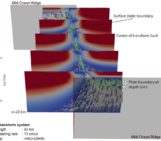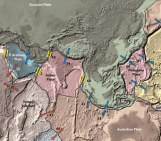
For the first time in 2006 Cannat and co-workers described a smooth seafloor type in the mid-ocean ridge located in the SW Indian Ocean (SWIR). The 660-km-long off-axis bathymetry, gravity, and magnetic dataset presented in the study lies near the Rodrigues triple junction (RTJ in Fig. 1). The must read paper expanded the previous conceptual models that considered mid ocean ridges as primarily volcanic systems, and set the SW Indian ridge as the archetypal melt-poor ultra-slow seafloor spreading ridge. Cannat and co-authors first describe tectonic and magmatic processes that occur along axes of melt-poor portions of ultra slow ridges over 26 My. Using gravity anomalies and modeled crustal thickness, mapped seafloor morphology and dredged samples, the authors identify then a well-organized lateral variation in seafloor bathymetry and lithology. They conclude comparing the observations with numerical model results for a spreading lithosphere.

Fig. 1 Location of the study area along the SW Indian ridge. Conceptual across-axis sketches of spreading centers (a and b). The crust (gray) is drawn on the basis of geophysical constraints, and formed by the combination of magmatic flows, intrusions, fault damage, and serpentinization. For clarity, only the most recent magmatic flows, intrusions, and infiltrations, and the most recently serpentinized domains are shown. No vertical exaggeration (from Cannat et al., 2019).
The authors identify three types of seafloor (volcanic, corrugated and smooth) that they correlated with three types of melt-poor ultraslow spreading. The “Corrugated-volcanic” spreading mode is characterized by dredged fault rocks, a bathymetry with domes, and spreading-parallel undulations of the seafloor (Fig. 1), elements that are compatible with footwall rotation of large offset normal faults. The “Smooth” spreading mode has at least partly serpentinised mantle dredged samples and is characterized by volcanic cones. The “Volcanic-Volcanic” sea-floor spreading mode is characterized by fault scarps and horst-graben geometries (Fig. 1).
Being a previously-undefined spreading mode, the most interesting is the smooth spreading mode. The authors observed the smooth terrains in the SW Indian Ridge concentrated in flow lines, expressed as parallel bands in the oblique spreading region. They interpreted the distribution of the terrains as an effect of spreading obliquity on melt supply. The obliquity would have favoured a volcanic spreading by limiting the lateral propagation of dikes from nearby volcanic centers. Gravity data helps support that these smooth terrains are associated with a very long lasting tectonic asymmetry of this segment of the ridge axis. This, alongside the distribution of corrugated surfaces, lead to the inference of flipped polarity of faulting over periods of a few million years.
Studies in the last 15 years focused on what led to long-lasting axial tectonic asymmetry and on the mechanism of frequent flips in the polarity of the faults. Recently, a mechanism related with melt supply has been identified as fundamental in allowing the spreading center to switch from the volcanic to the detachment-dominated mode (e.g. Cannat et al., 2019). Lack of volcanism as outlined by the authors does not necessarily imply a magmatic divergent margin: thick lithosphere can favour melt crystallization at depth. Differences in magmatism in segments of the SWIR and consequences in ore deposits exploration have also been recently tackled (see e.g. Zhou et al., 2022).
Another new venue for research comes from the suggestion that mantle exhumation processes occurring at passive margins could be analogous to mantle core complex at ultra-slow spreading ridges (Cannat et al., 2019), although divergence rates and melt supply during the OCT phase cannot be strongly constrained.
Check out these videos (1 & 2) and/or podcast if you want to know more or get an introduction to the topic
Written by Gianluca Frasca, David Férnandez-Blanco, Benoît Petri and the TS Must Read team
References
Cannat, M., Sauter, D., Lavier, L., Bickert, M., Momoh, E., Leroy, S., 2019. On spreading modes and magma supply at slow and ultraslow mid-ocean ridges. Earth and Planetary Science Letters 519, 223–233. https://doi.org/10.1016/j.epsl.2019.05.012
Cannat, M., Sauter, D., Mendel, V., Ruellan, E., Okino, K., Escartin, J., Combier, V., Baala, M., 2006. Modes of seafloor generation at a melt-poor ultraslow-spreading ridge. Geology 34, 605–608. https://doi.org/10.1130/G22486.1
DeMets, C., Merkouriev, S., Sauter, D., 2021. High resolution reconstructions of the Southwest Indian Ridge, 52 Ma to present: implications for the breakup and absolute motion of the Africa plate. Geophysical Journal International 226, 1461–1497. https://doi.org/10.1093/gji/ggab107
Zhou, F., Dyment, J., Tao, C., Wu, T., 2022. Magmatism at oceanic core complexes on the ultraslow Southwest Indian Ridge: Insights from near-seafloor magnetics. Geology 50, 726–730. https://doi.org/10.1130/G49771.1




